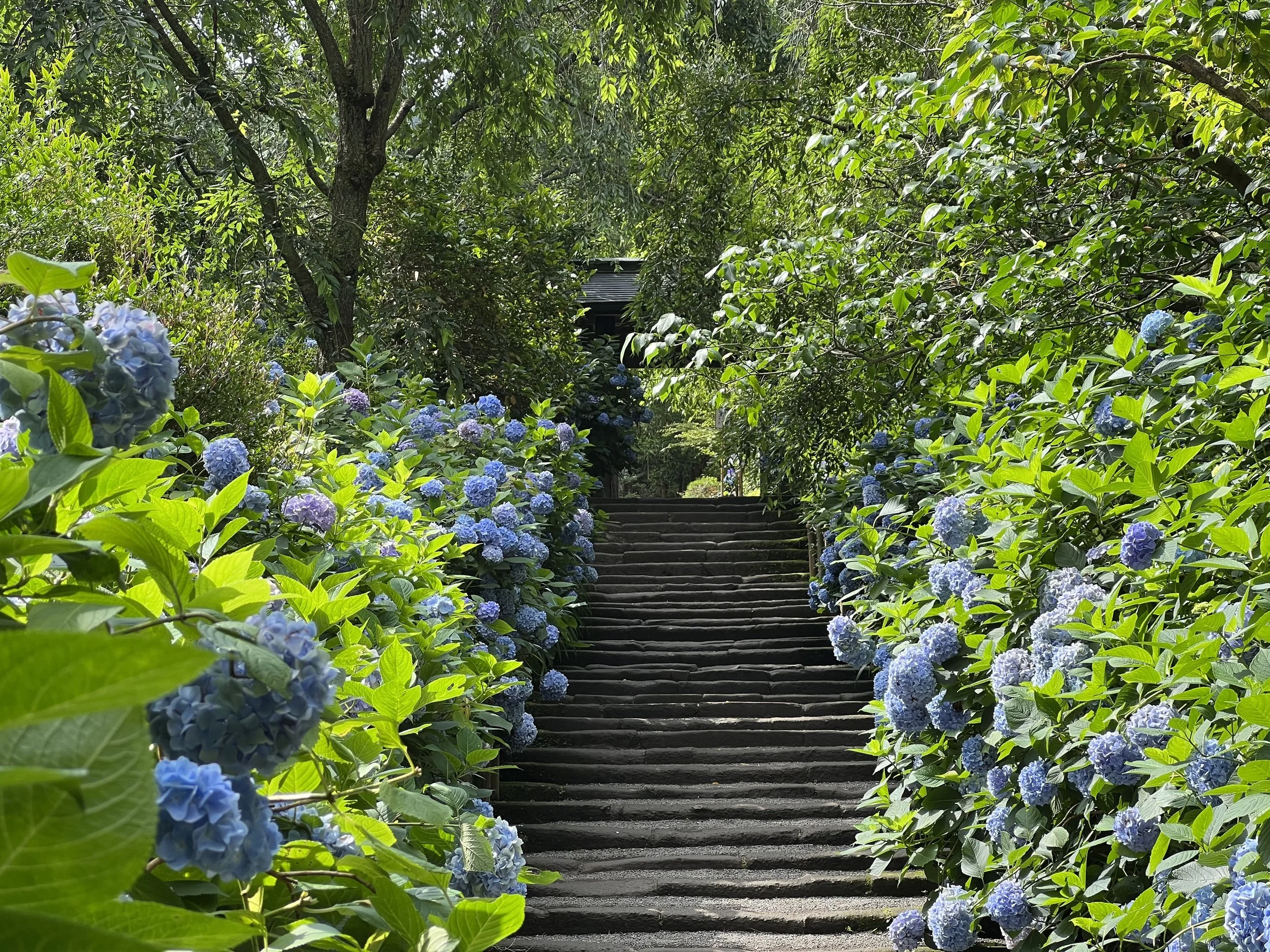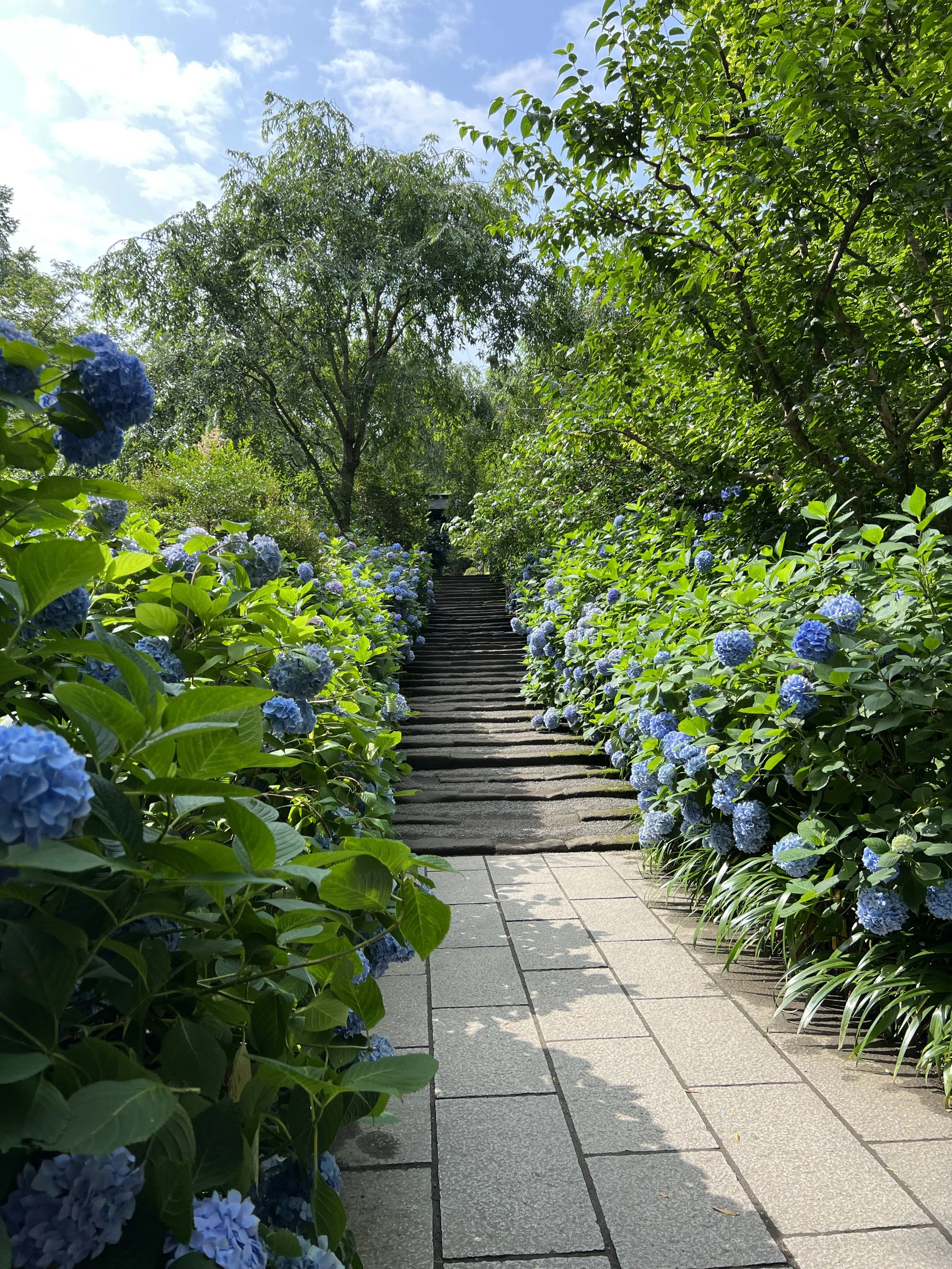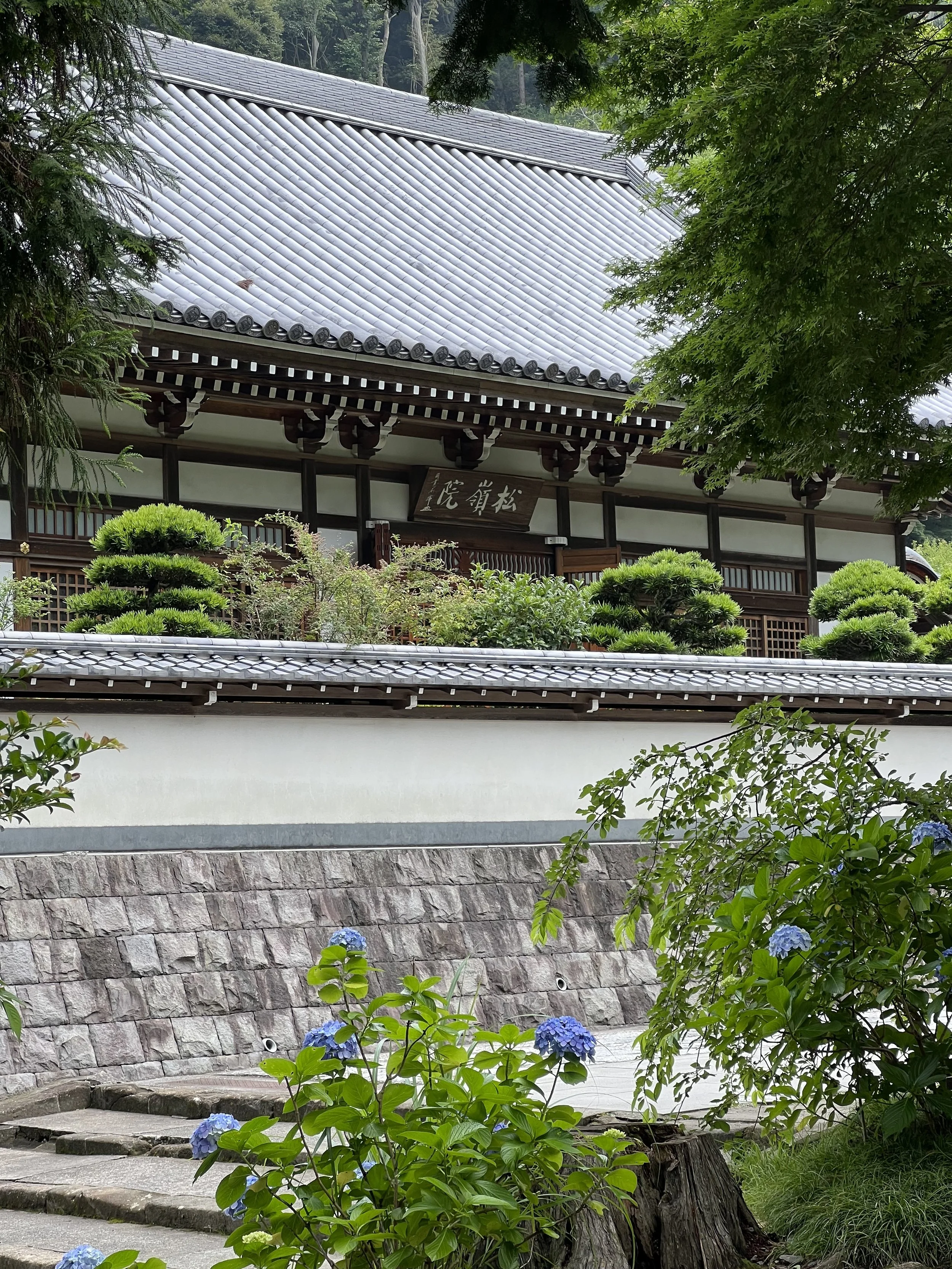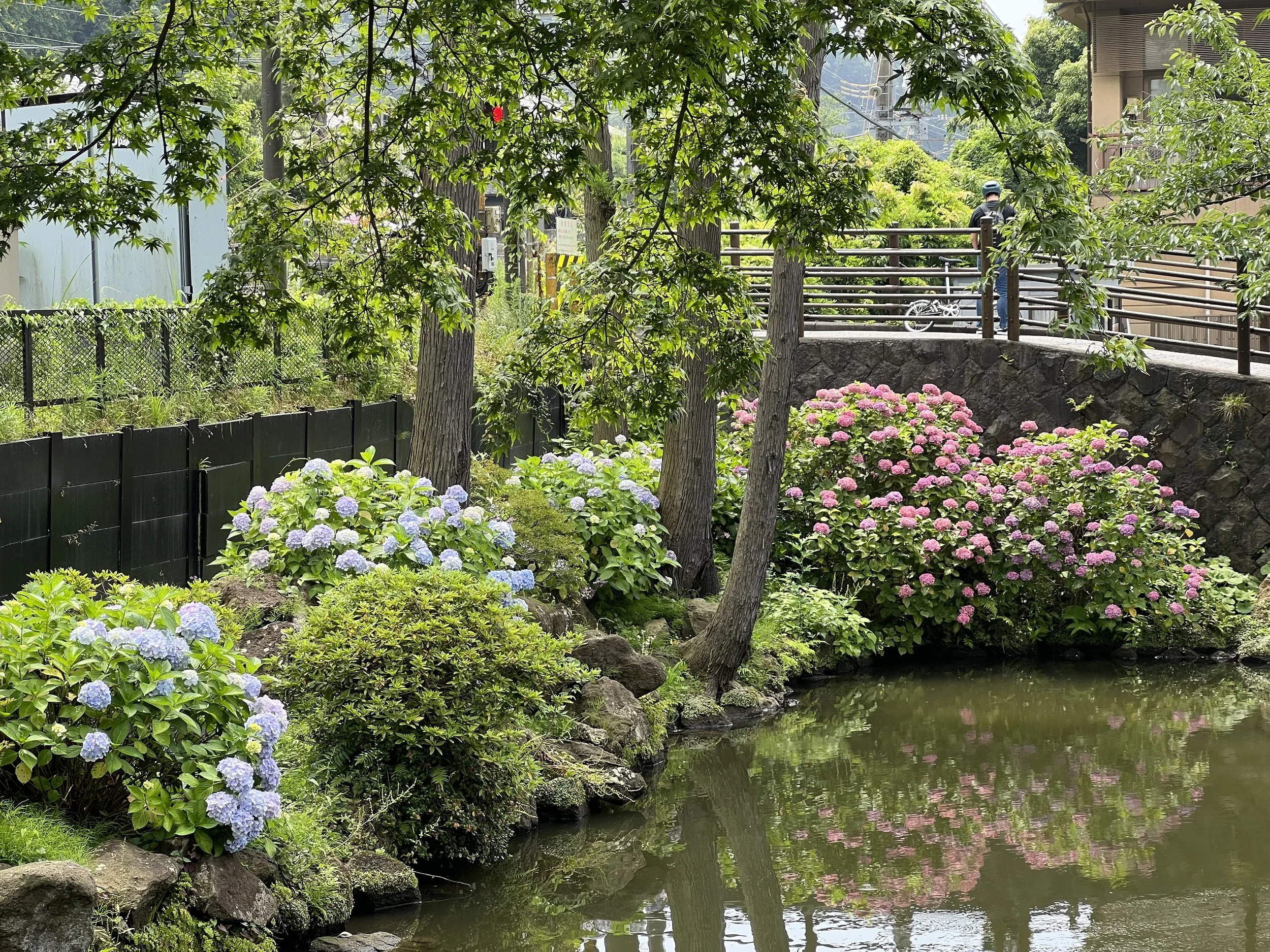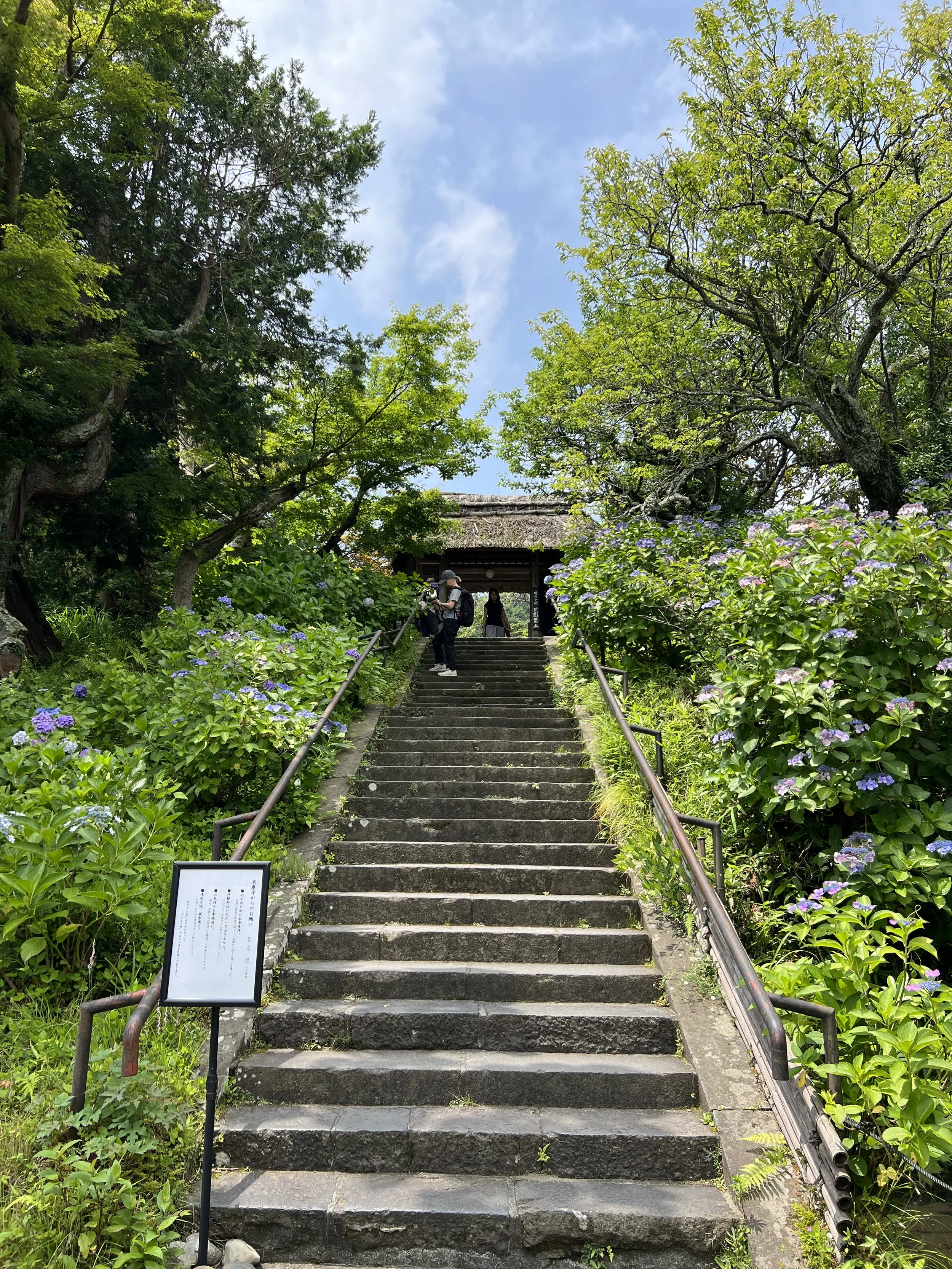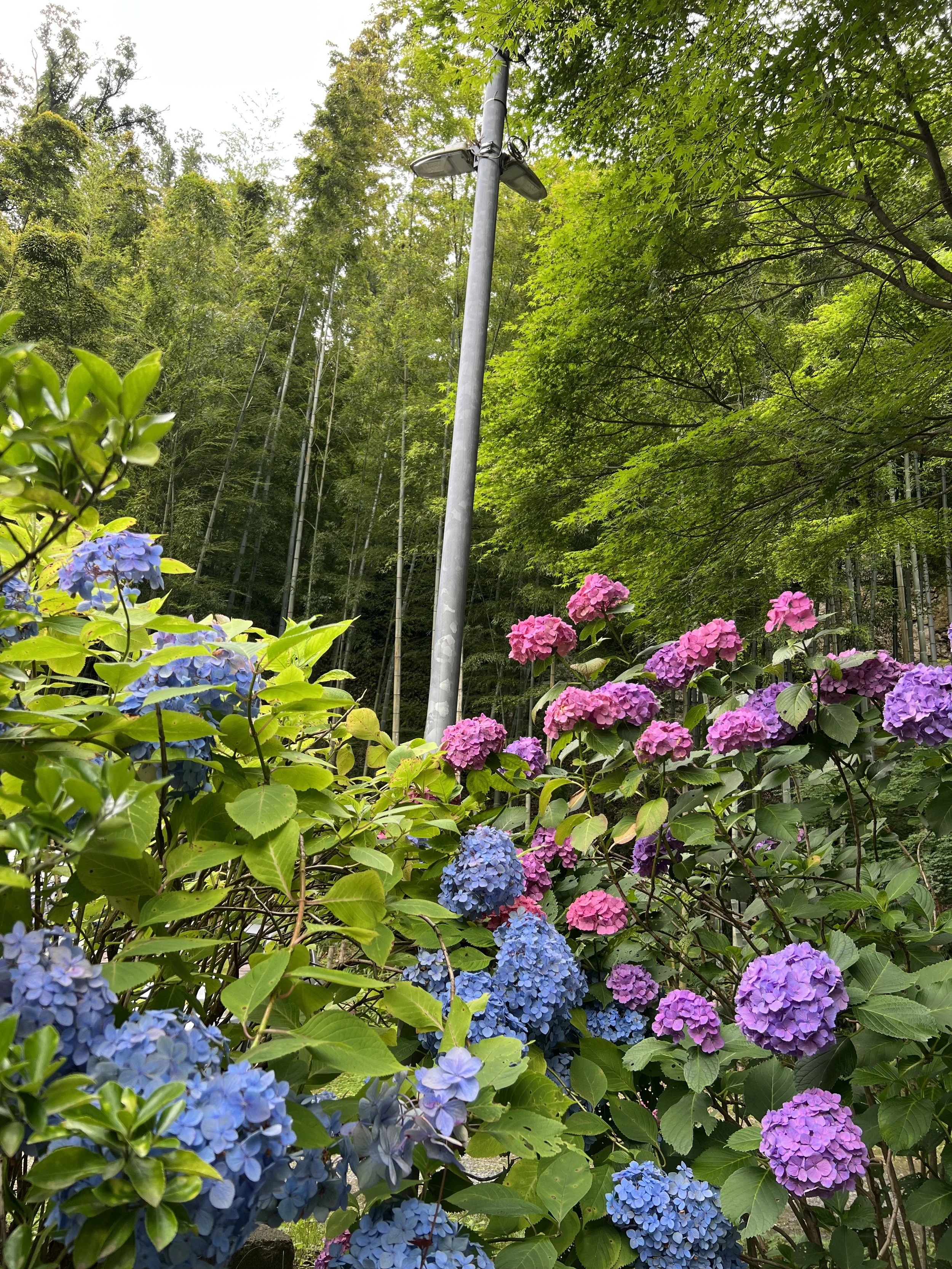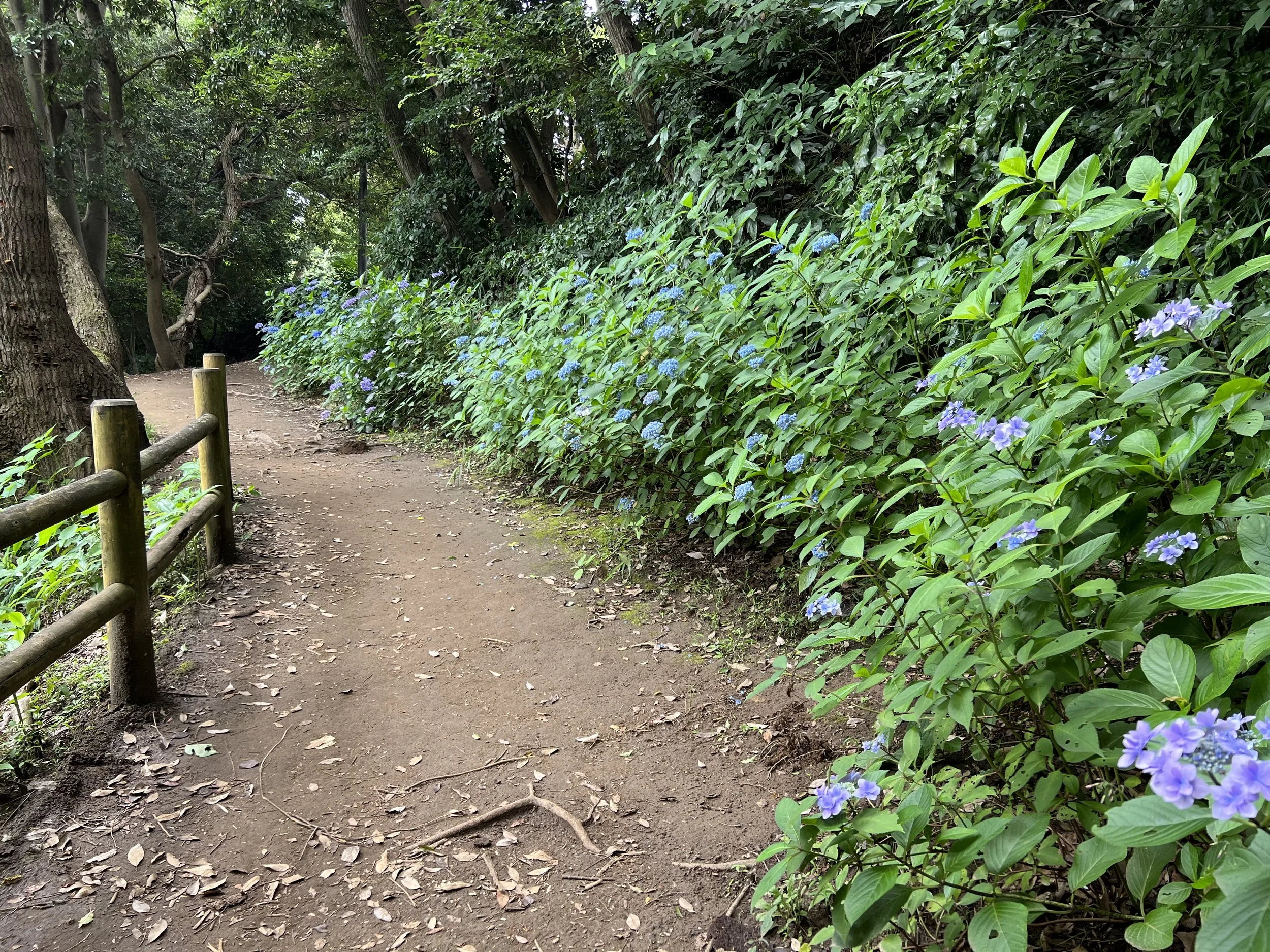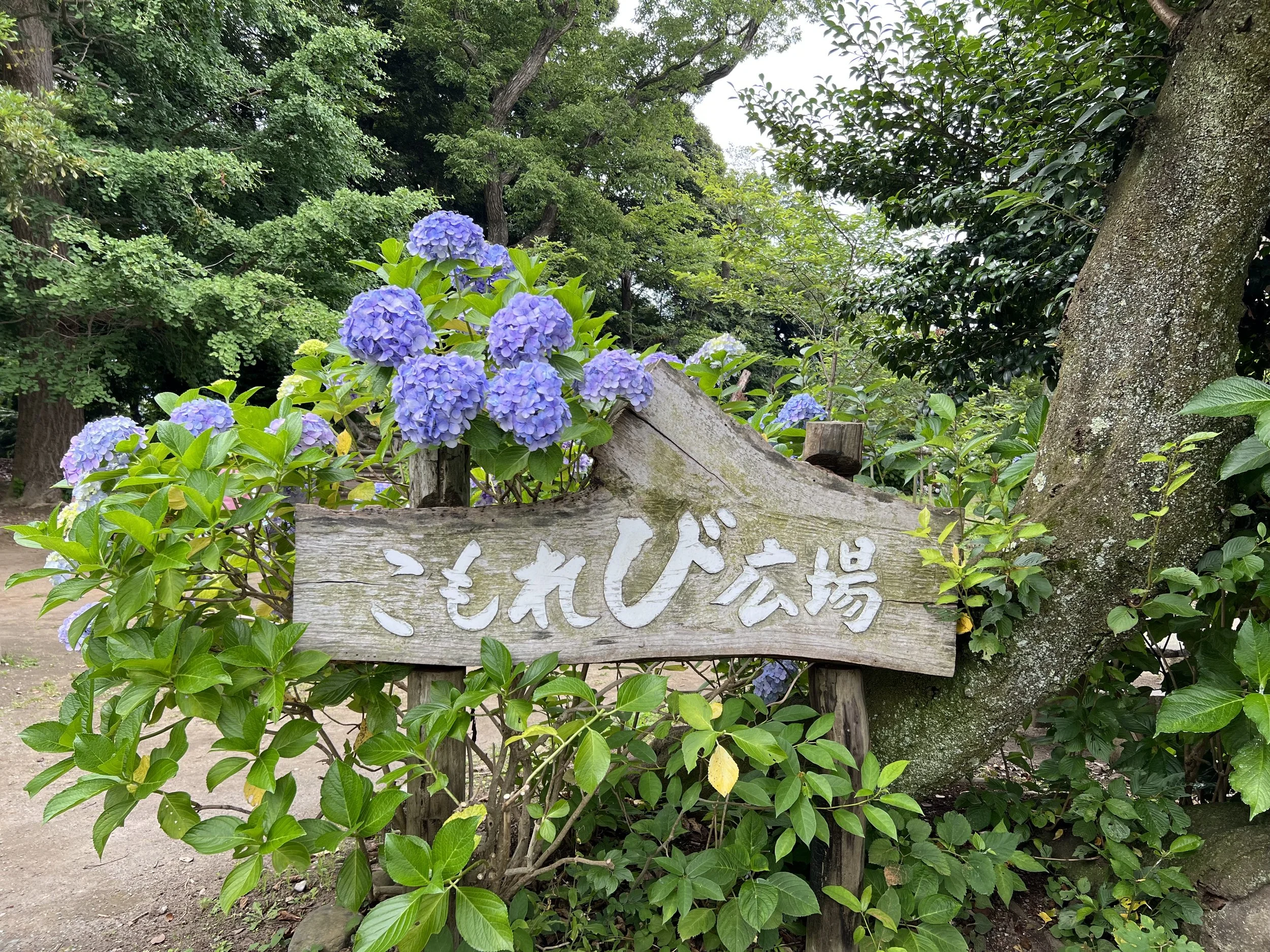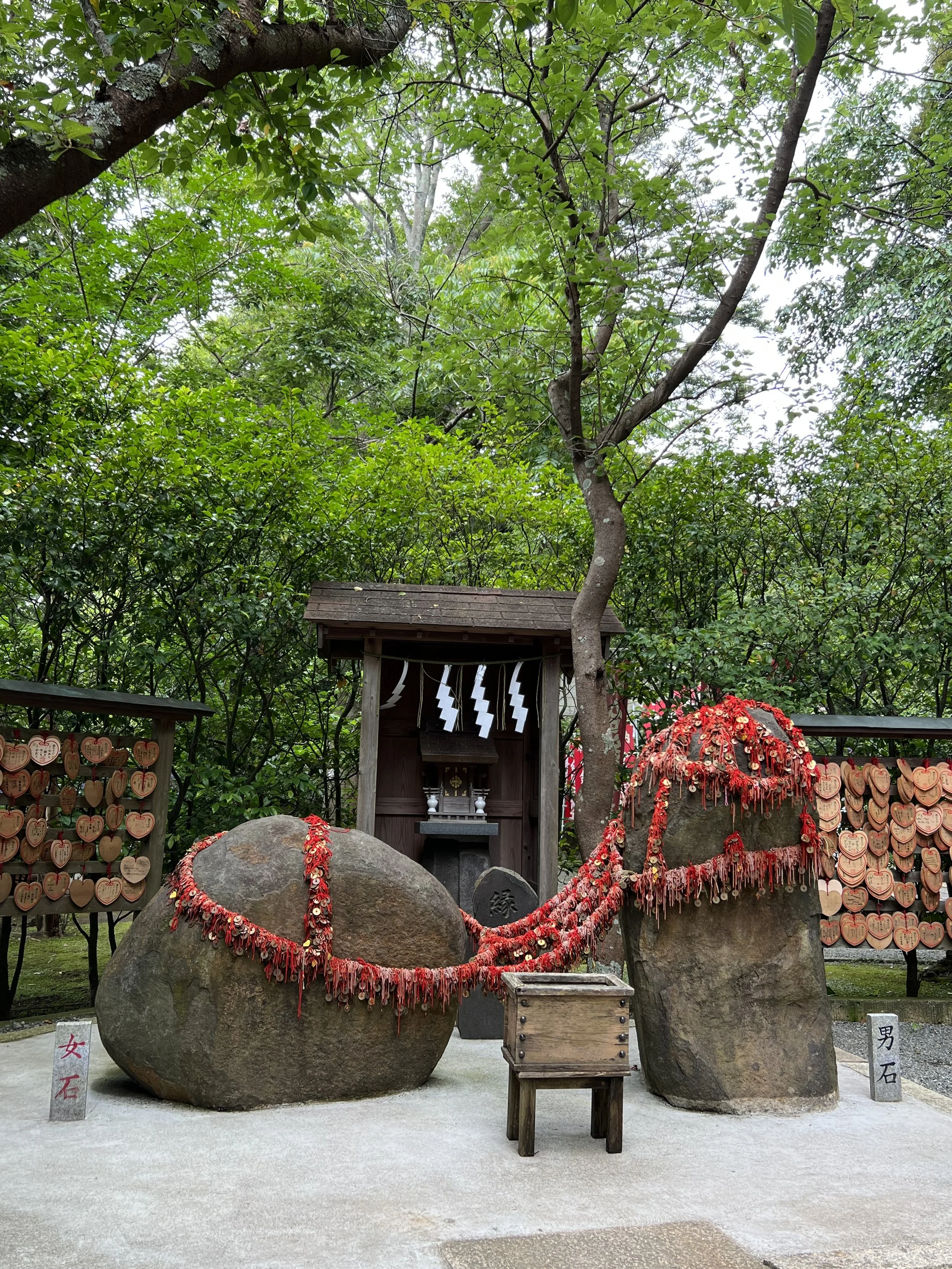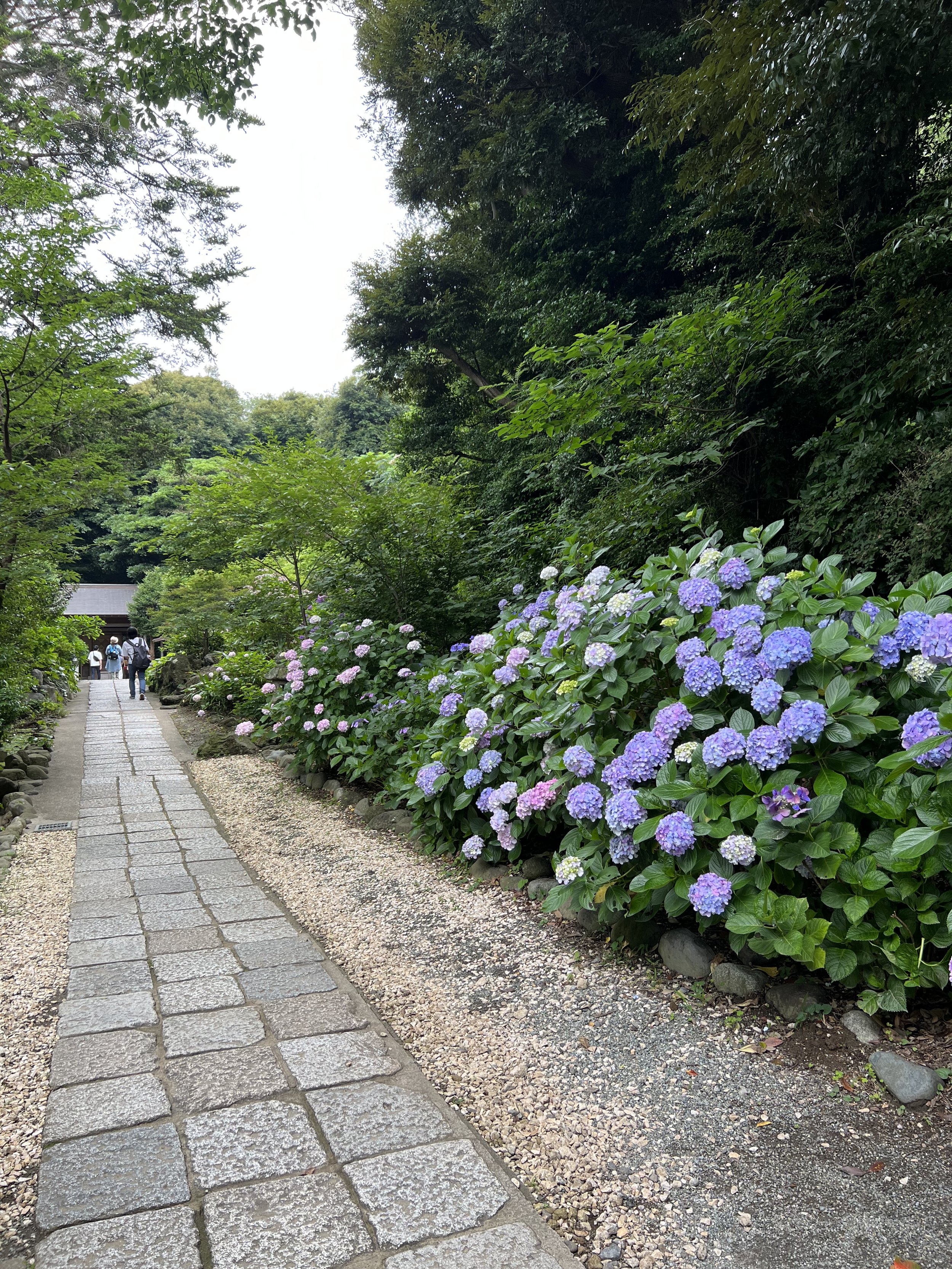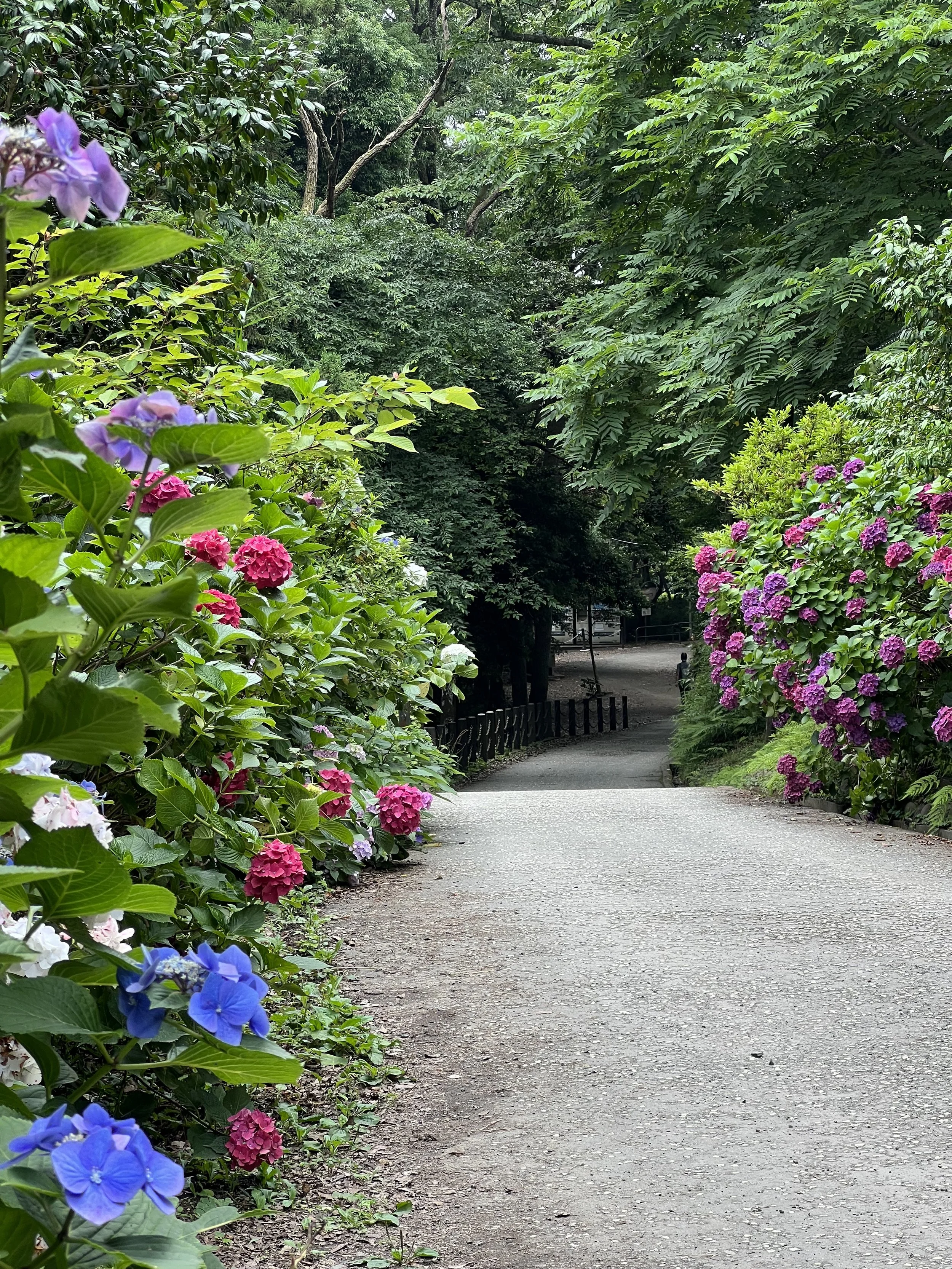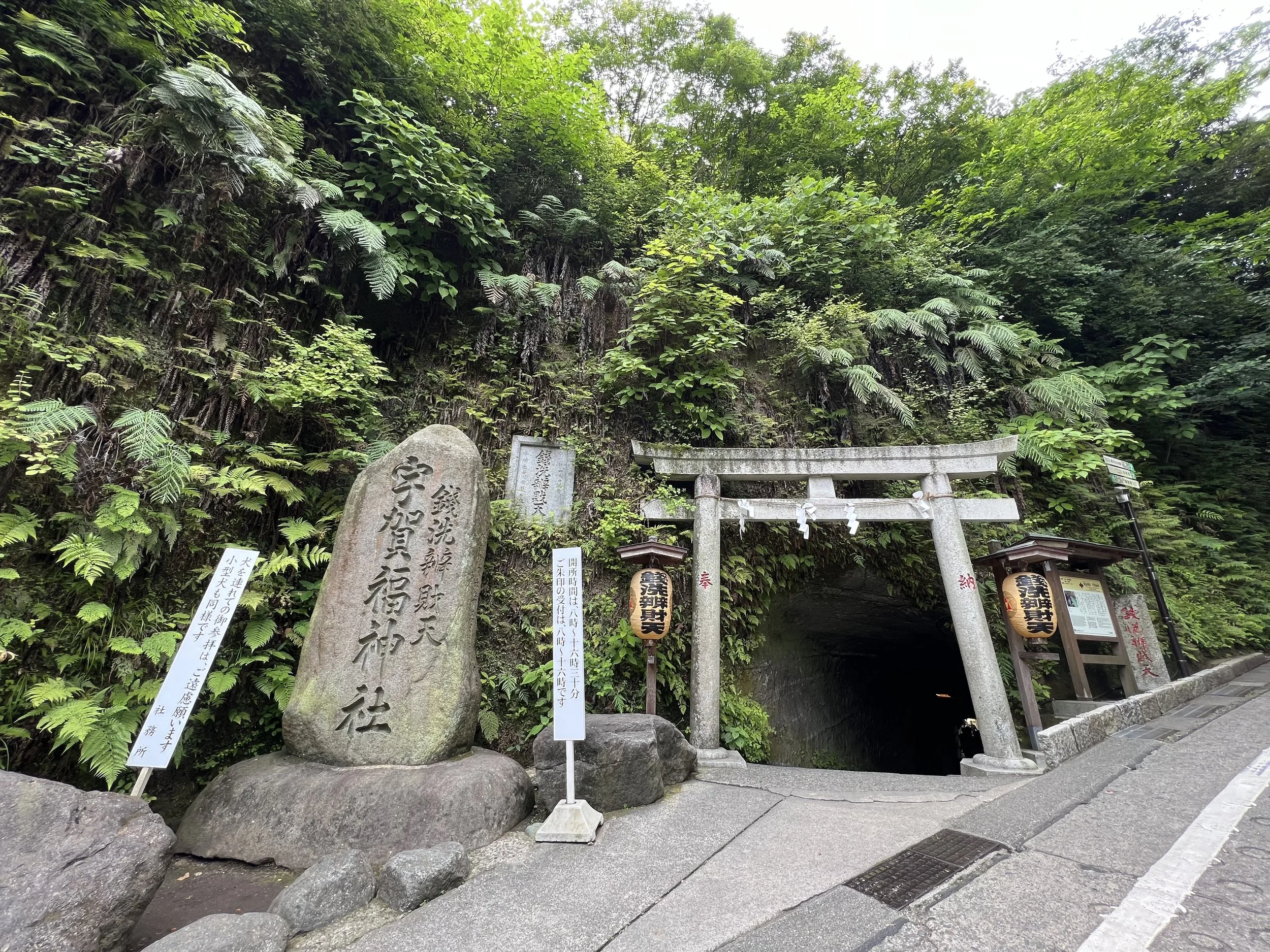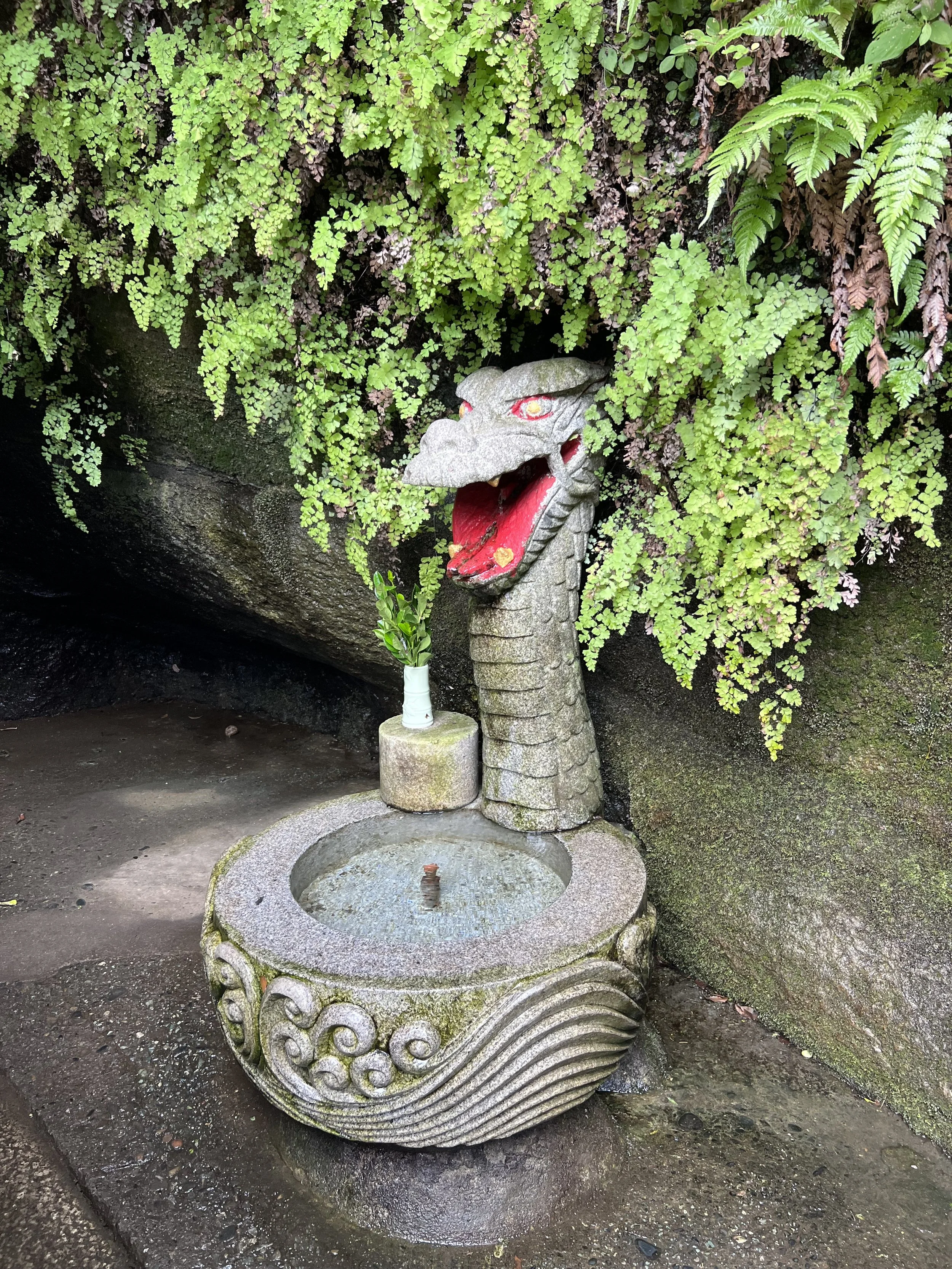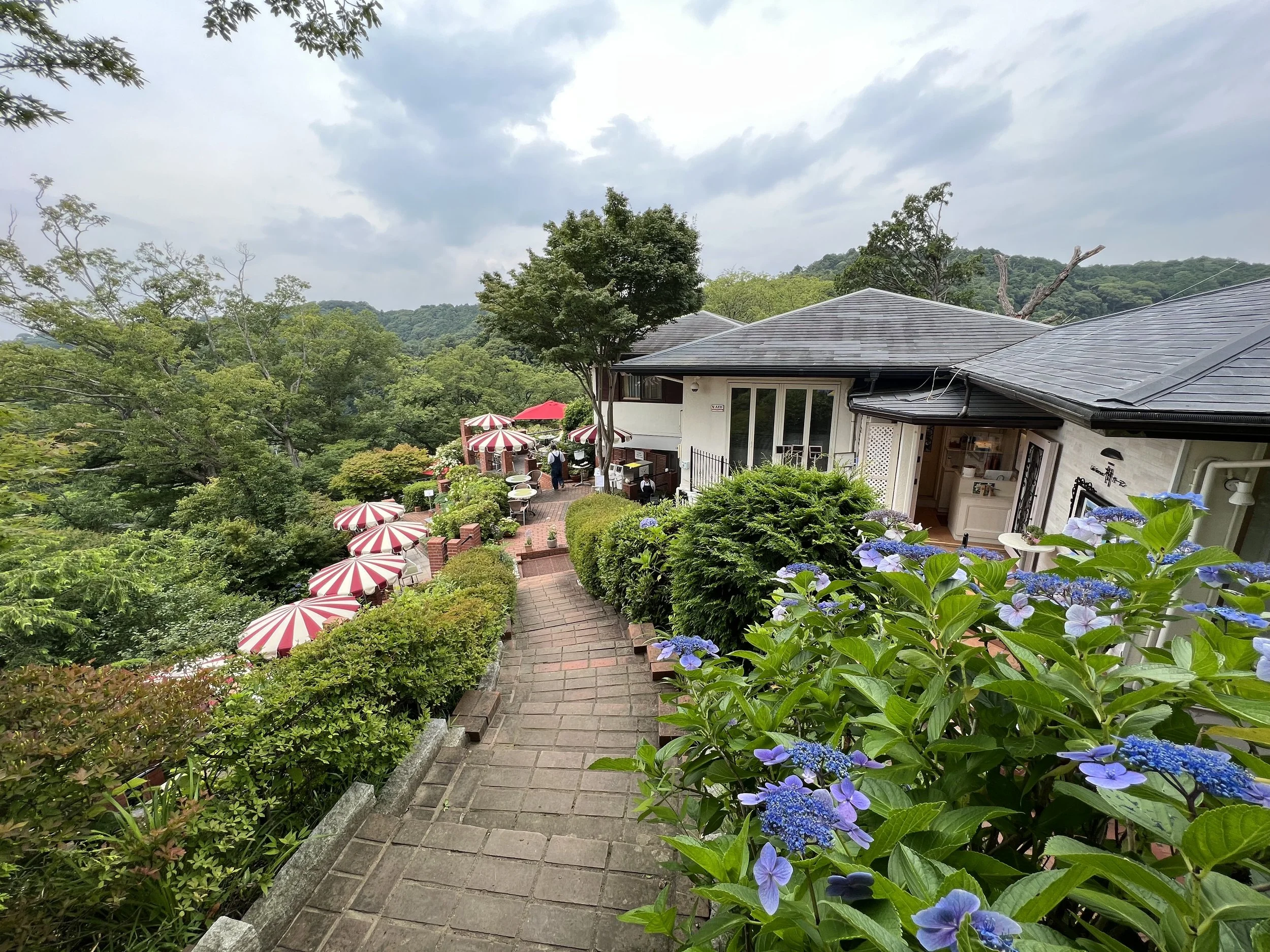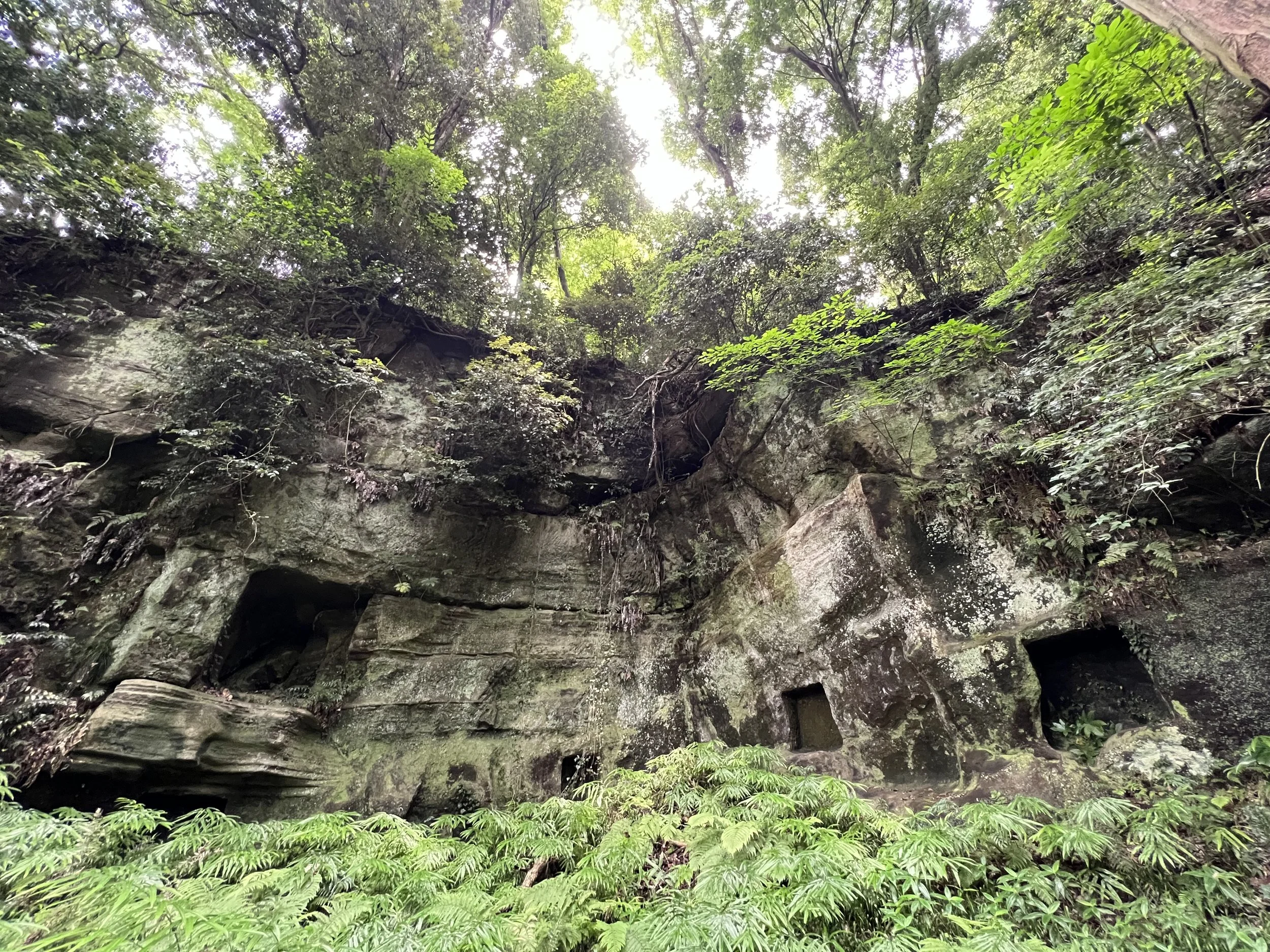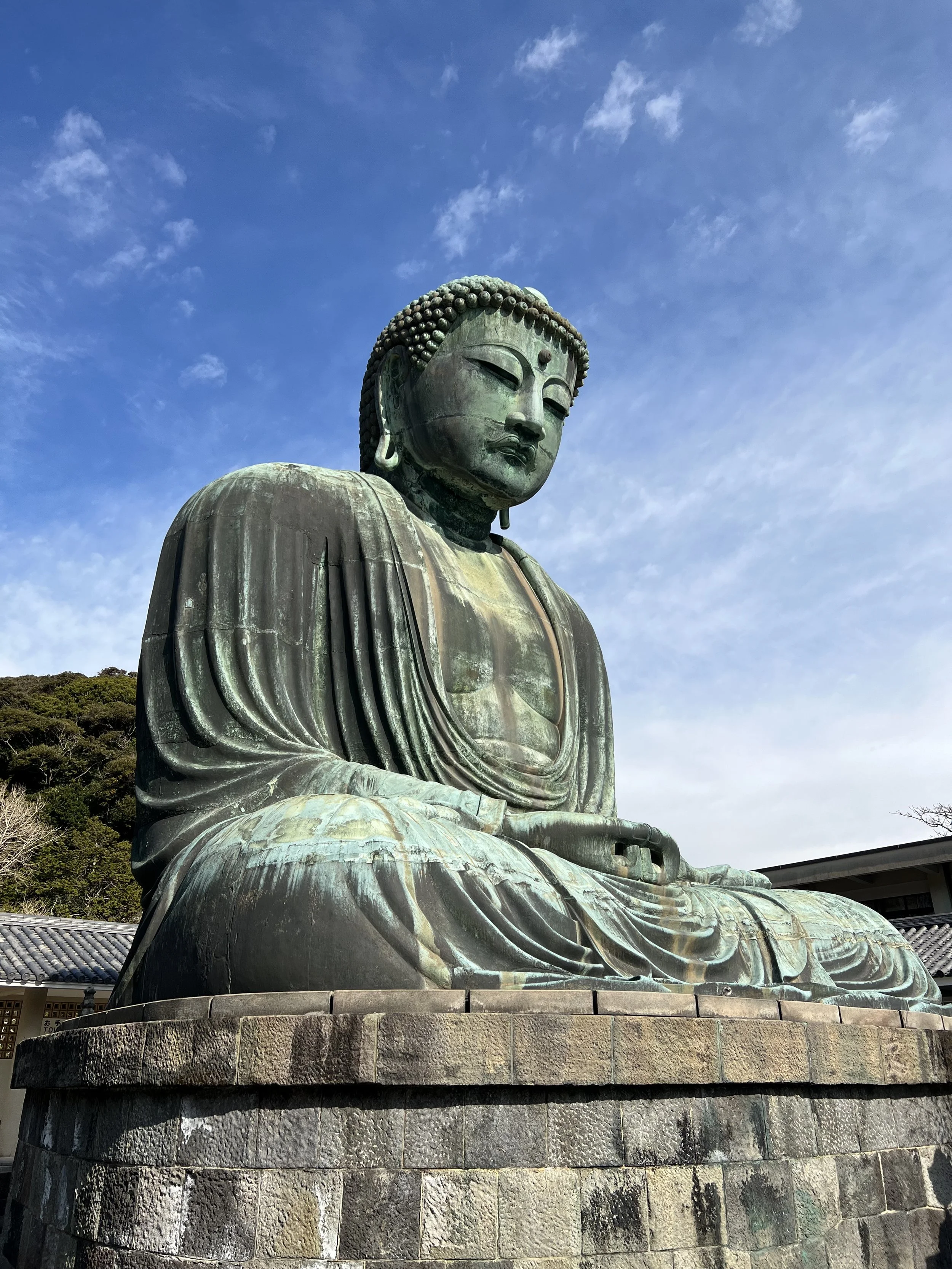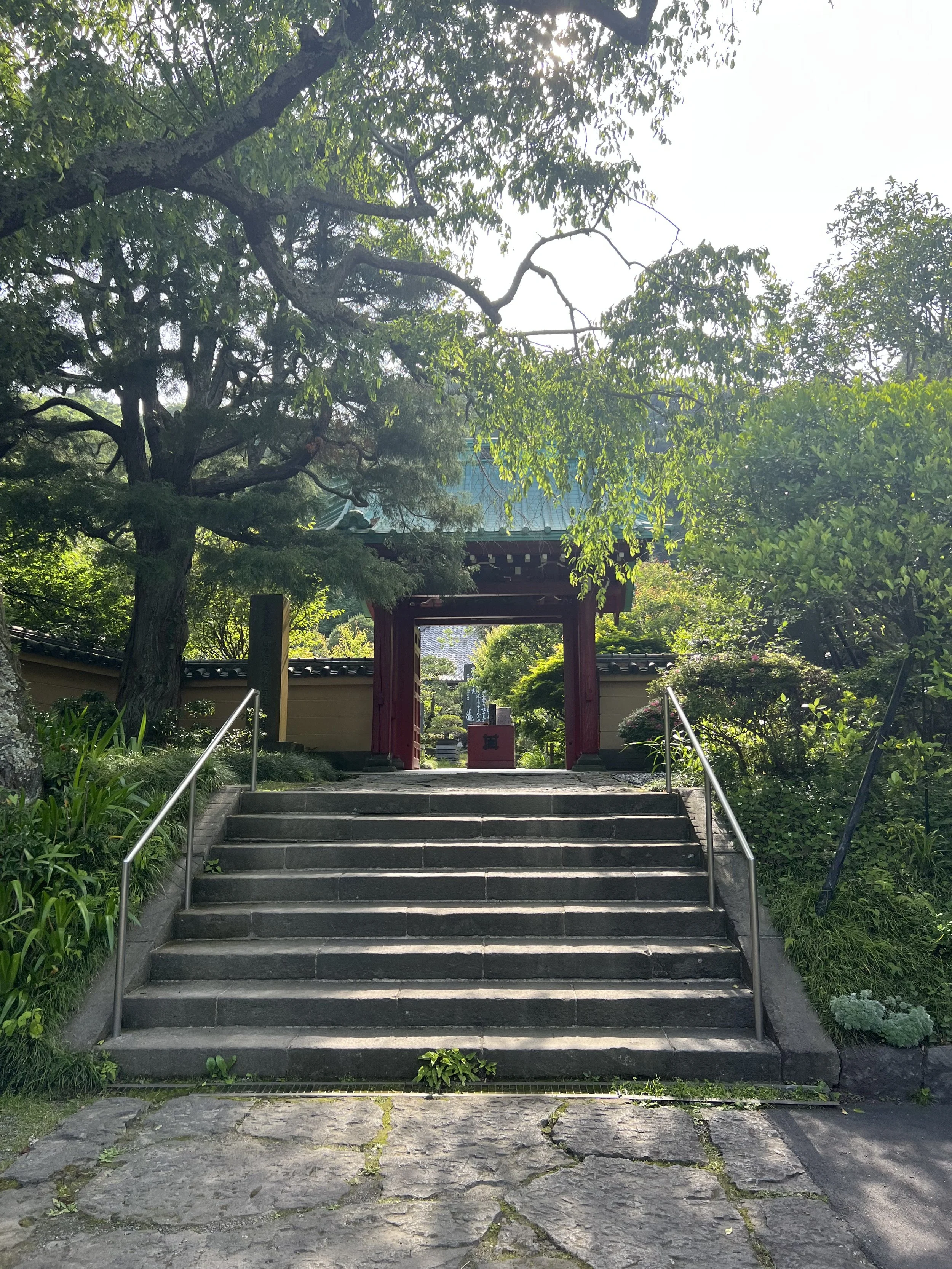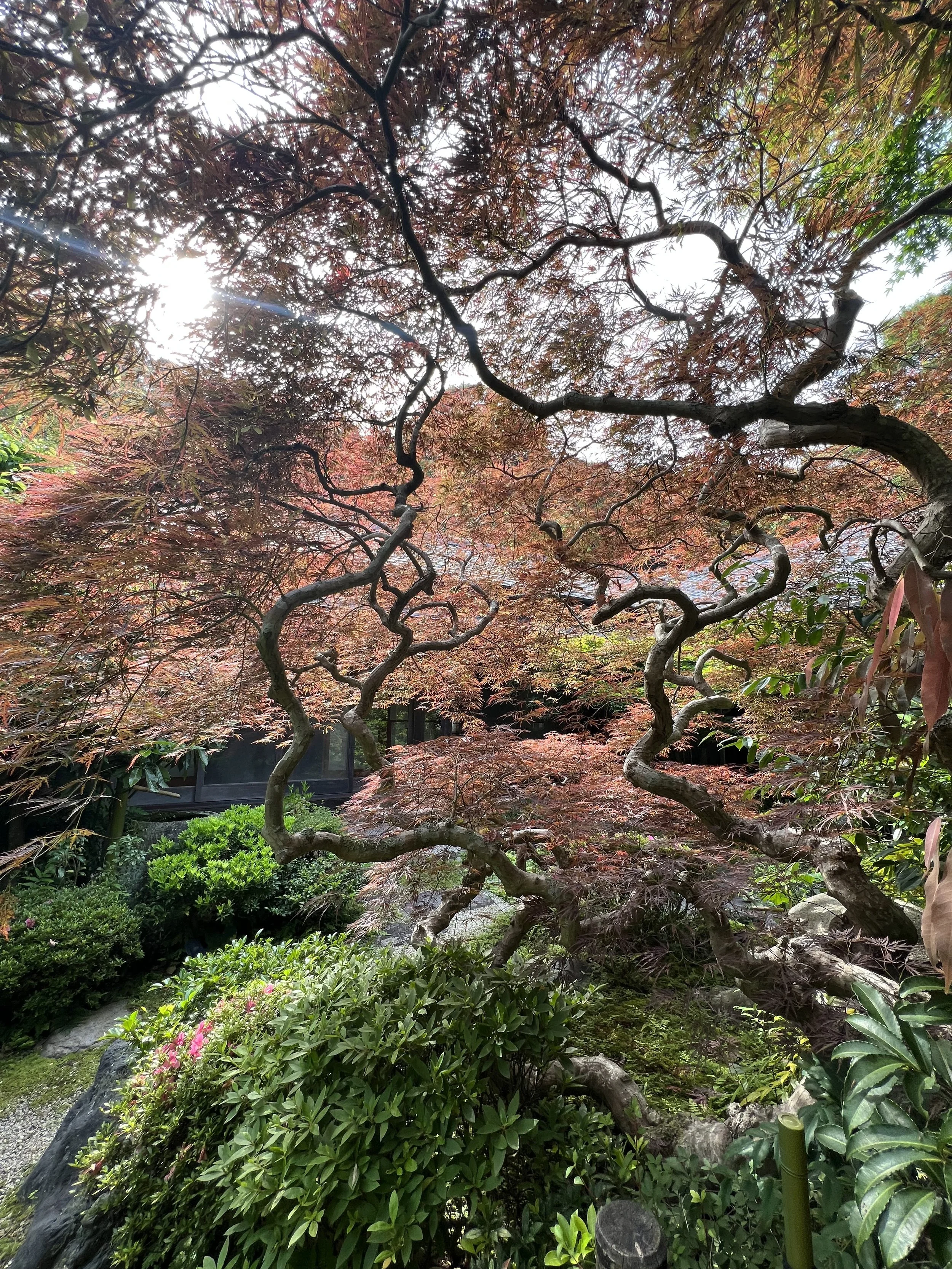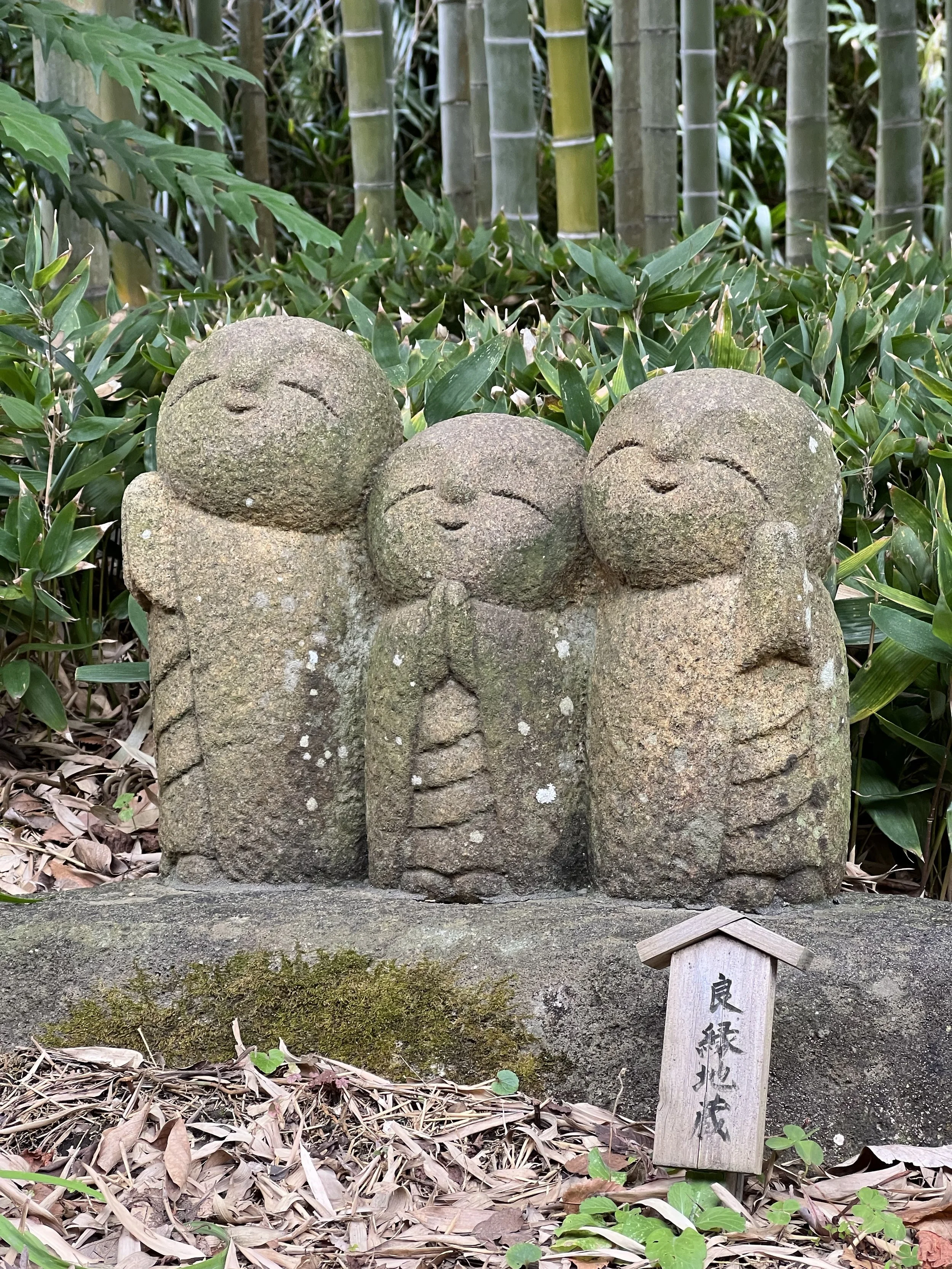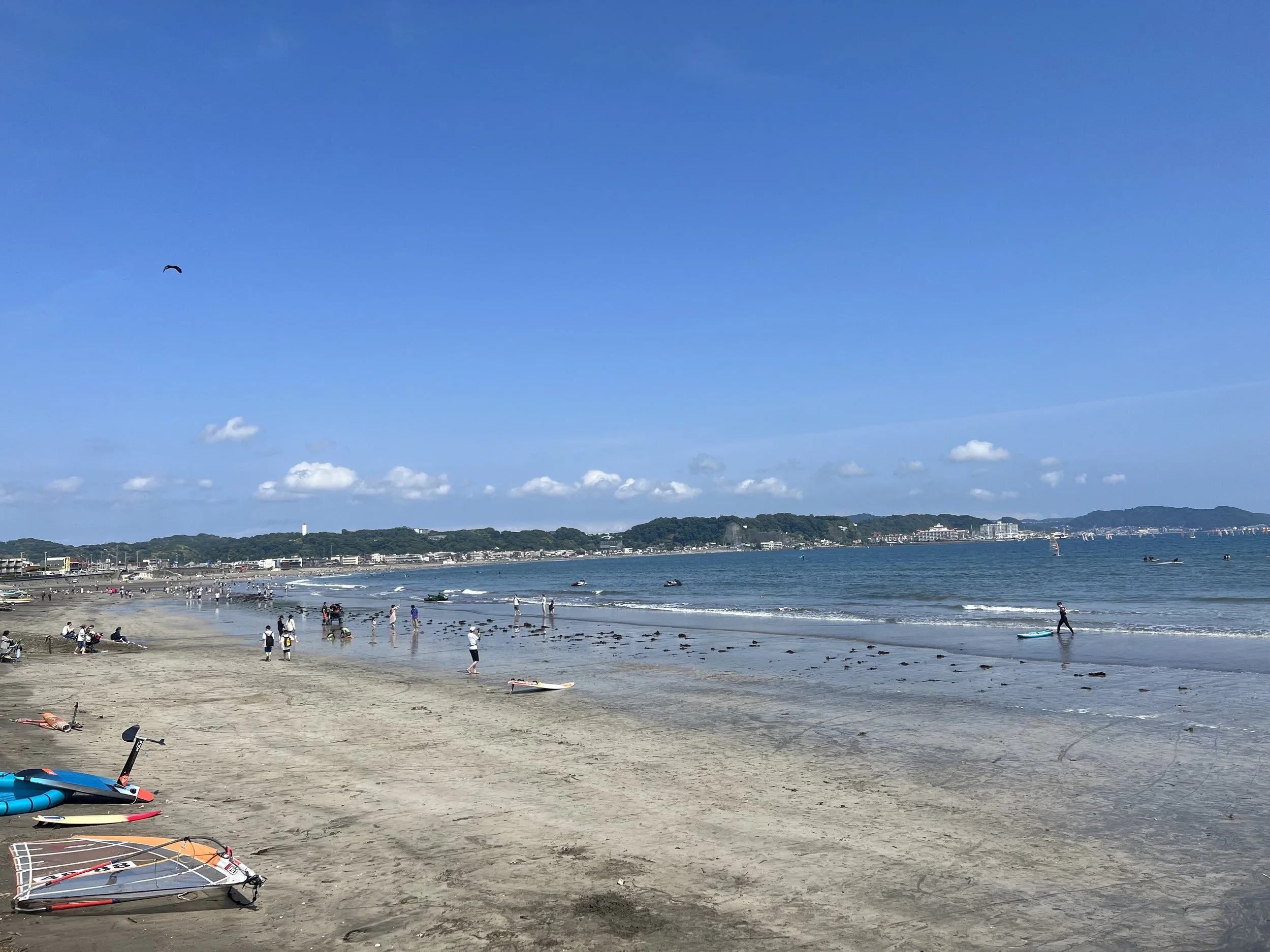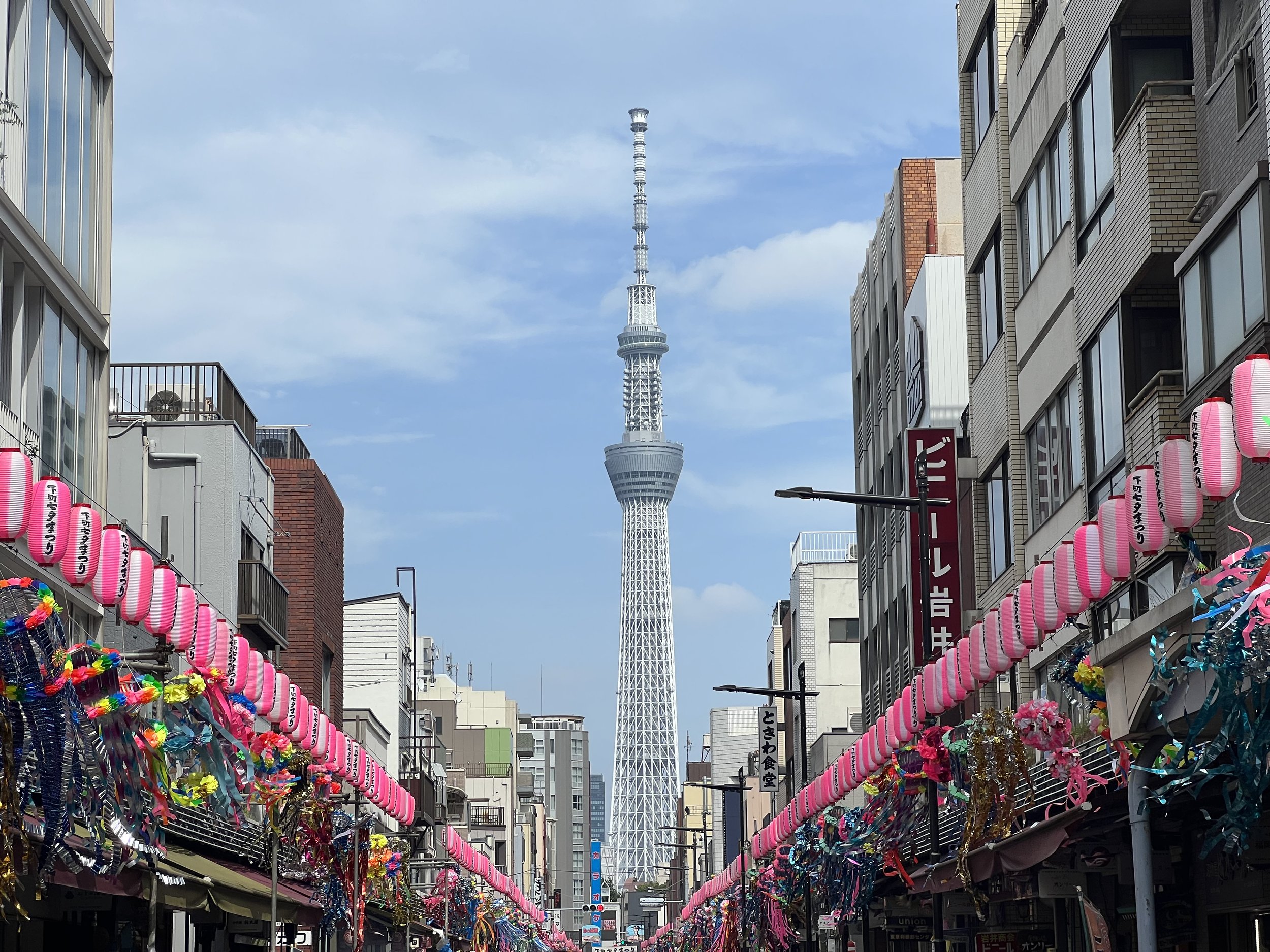Discover Kamakura’s Hydrangeas: Perfect One-Day Itinerary
Kamakura (鎌倉) is a fantastic and popular destination for a day trip from Tokyo, and especially in June when the rainy season transforms this ancient city full of temples and other sites into a hydrangea fairytale.
In this article, I’ll share the exact walking itinerary I followed to experience the best of Kamakura’s hydrangea season, including famous spots like Meigetsuin (the Hydrangea Temple), as well as a few lesser-known gems I personally enjoyed. Whether you're planning your first Kamakura trip or returning to explore new corners, this guide will help you make the most of the 2025 hydrangea bloom season.
Even if you miss the peak hydrangea bloom, this route offers a wonderful way to enjoy Kamakura’s temples, nature, and sea breeze in any season. I’ve also included a detailed map at the end of the post to make planning your day trip easier.
A Walking Itinerary in Kamakura to Admire Hydrangeas
As a flower lover, going on a ‘hydrangea hunt’ in Kamakura was high on my Japan Bucket List. So I planned my day trip to make the most of it, and the beauty of the hydrangea spots I saw exceeded all my expectations. Despite going on a Saturday, I was very surprised by the lack of crowds throughout my walk (with the exception of Meigetsu-in and Hasedera, which were very busy as they are popular for hydrangea viewing).
The starting point of this itinerary is Kita-Kamakura station (北鎌倉駅) on the Kamakura, Shonan-Shinjuku and Yokosuka lines.
Marvel at the Enchanting Beauty of Meigetsu-in, Kamakura’s Hydrangea Temple
The place I most wanted to see during that day in Kamakura was Meigetsu-in (明月院), a Buddhist temple founded in 1160, also nicknamed the “Hydrangea Temple” (あじさい寺).
Knowing how popular Meigetsu-in is during the hydrangea season, I decided to arrive early and was there more than 30 minutes before it opened its gates at 8:30am. And I was right to do so, as there was already a queue of about fifty people ahead of me who had had the same idea. But once the temple opened, I waited less than 5 minutes to enter the temple, after paying an entrance fee of ¥500.
And the early morning wake-up was well worth it. There were thousands of blue hydrangeas in full bloom in big bushes, a view which is called “Meigetsu-in blue”. Beyond the idyllic scenery, I could see the care and effort put into celebrating the hydrangea season, with bouquets of hydrangeas on the statues or floating on water basins. No wonder this temple was so highly recommended for hydrangea viewing.
Meigetsu-in blue
Go Hydrangea Hunting while Exploring Kita-Kamakura’s Temples: Engaku-ji, Tokei-ji and Jochi-ji
After this first magnificent hydrangea spot, it was time to explore more of the Kita-Kamakura area. I decided to go next to the nearby Engaku-ji (円覚寺), a large Buddhist complex, with several buildings and areas to visit, and lots of hydrangeas. I also paid an entrance fee of ¥500 and it was much less crowded than the previous temple.
Engaku-ji
Back in the streets of Kita-Kamakura, I walked by a little pond called Shirasagi Pond (白鷺池) next to the train station, also surrounded by hydrangeas.
Shirasagi Pond
As I walked south towards the beginning of the hiking trail I was going to follow next, I saw a staircase on my right leading up to a temple, with hydrangeas on either side.
Curious, I decided to take a look, and to explore the gardens leading to the peaceful Tokei-ji (東慶寺). Founded in 1285, this buddhist temple has an interesting history as a nunnery and a refuge for women who were abused by their husbands.
Pictures were not allowed past the gate, but know that this temple’s lush garden of this temple is a feast for the eyes, also filled with hydrangeas.
Tokei-ji
Continuing my walk, I decided to visit another temple in Kita-Kamakura called Jochi-ji (浄智寺), where I enjoyed the serene atmosphere of this temple, beautiful nature, and a few interesting sights and statues.
Jochi-ji
Hike the Daibutsu Hiking Trail to Genjiyama Park
Time for a hike! Next to Jochi-ji is the start of the Daibutsu hiking trail, which connects Kita-Kamakura and the Great Buddha (Daibutsu) in Kotoku-in in the west of the city. The forest path winds through the hills, giving hikers access to several lesser-known temples and shrines, away from the crowds. Note that the trails are not paved and are sometimes steep and narrow.
The hydrangea hunt was going very well, as there were plenty along the way, especially once I reached Genjiyama Park (源氏山公園). In particular, there is a lovely rest area with picnic tables next to Kuzuharaoka Shrine (葛原岡神社), which were surrounded by hydrangeas. What better place for a lunch break!
I particularly enjoyed visiting the small, serene Kuzuharaoka Shrine. It has a small pond in which turtles and koi fish swim, and has become a popular power spot for couples who come and pray in front of matchmaking stones (Wife-and-Husband Stones, 縁結び石).
Kuzuharaoka Shrine
Genjiyama Park is a hidden gem and a must-see in Kamakura during hydrangea season. It was so peaceful, and I was surprised to often find myself alone amongst the hydrangeas (as you can see from the photos below), as if this place was out of this world.
Stop by the Zeniarai Benten Shrine and Discover its Money Washing Ritual
If like I was, you are not yet too tired of shrines and temples, there are two not-to-be-missed shrines within walking distance of Genjiyama Park (although they are not hydrangea spots). The first is Zeniarai Benten Shrine (銭洗弁財天 宇賀福神社). This shrine is free to visit and it was fun to access it passing through a tunnel. It also has an interesting ritual: it is said that money washed in the shrine's spring will multiply! I didn't do it myself, but I enjoyed watching people washing coins and ¥1,000 notes in a basket in a cave stream next to the shrine.
Entrance to Zeniarai Benten Shrine
Money Washing Ritual
Another shrine a few hundred meters away called Sasuke-Inari Shrine (佐助稲荷神社). Unfortunately, I didn’t know about it on my walk, but I would have loved to go there as this little shrine seems quite atmospheric, being decorated with countless little fox statues and a long row of torii gates.
Take a Break at Itsuki Garden
Time to continue the Daibutsu hike, with some beautiful views of Kamakura and the coast that were a great reward and motivation for the rest of the hike. After a bit, if you’d like, you can take a little detour to check out Itsuki Garden (樹ガーデン), a café that seems to come out of nowhere, with a spacious multi-level terrace and views of the forest, serving light lunches and pastries. The path to the café was cute, with hydrangeas on each side.
View of Kamakura from the Daibutsu Hiking Trail
Itsuki Garden
Finish the Daibutsu Hike by Visiting Kotoku-in
The rest of the route is mostly downhill. At one point, there is an intersection, and you can decide to stop the hike to join the main road to head to Kotoku-in, or continue a little further to walk the Daibutsu Kiridoshi Pass (大仏切通), a historic passage that was once one of the seven entrances to Kamakura. It's an extra 15-minute walk.
Daibutsu Kiridoshi Pass
Back on the main road, it was time to head to Kotoku-in Temple (高徳院). Kotoku-in is one of Kamakura's most popular temples and so can be another great stop to add to your walking itinerary. The Great Buddha of Kamakura (鎌倉大仏), a 11 meter tall bronze statue of Amida Buddha built around 1252, is located on the temple grounds. You can even visit the inside of the Buddha by paying ¥20 on top of the initial entrance fee of ¥300.
Great Buddha of Kamakura in Kotoku-in
Enjoy the Peaceful Atmosphere at Kosoku-ji Temple
As you walk down the main street, you may want to stop at some of the shops for street food treats. In that case, I recommend the delicious dango snacks at Japanese confectionery shop Takeya (竹や).
On the right, there is an alley leading another little-known and serene temple, called Kosoku-ji (光則寺). There is a ¥100 donation fee to enter the shrine, that you need to leave in a wooden box at the entrance. It has a beautiful garden, with flowering trees and plants, including hydrangeas. I fell in love with this temple the first time I visited, and stayed there for a while to soak in the peaceful atmosphere, with only the sounds of birds and frogs surrounding me.
Entrance to Kosoku-ji
Visit Hasedera if Crowds Allow
Just below Kosoku-ji, Hase-dera (長谷寺) is another of the most popular temples of Kamakura to visit all-year round. With more than 2,500 hydrangea plants of 40 species are planted in Hase-dera, it is also very popular during the hydrangea season, like Meigetsu-in. It can therefore be extremely busy, especially at weekends.
Although this is my favourite temple in Kamakura, I wasn't ready for the crowds and I'd been very happy with my hydrangea hunt so far, so I decided to skip it this time.
But if you've got any energy left, you might want to include it in your walking itinerary! Hase-dera is a large temple full of picturesque spots, so it will probably take you 1-2 hours to visit. Note that during peak season, visitors may need to obtain a time ticket upon arrival in order to enter the “Hydrangea Path”, so be prepared to queue.
Hase-dera’s cute Jizo statues
Finish your Day at the Beach or/and in a Cafe
My final recommendation to end this itinerary: a little relaxation! The weather is already hot and humid in June. Weather permitting, you could take a dip in the Pacific Ocean on Kamakura’s beach to cool off after your long walk. Another idea is to relax in one of Kamakura's many cafés. My pick, which I tried at the end of this day and recommend with no hesitation: Oimo Cafe Canary (おいもカフェ 金糸雀), located just off Komachi-dori Street, which serves superb and delicious Japanese desserts. Please note that this café is small and you may have to wait a little before being seated.
由比ヶ浜
Dessert at Oimo Cafe Canary
My Kamakura Itinerary in a Map
A Few Travel Tips to Make the Most of This Hydrangea Day Trip in Kamakura
Best Time to See Hydrangeas in Kamakura
The hydrangea season runs from late May to early July. The peak is between mid-June and the end of June. For reference, the photos in this article were taken on 24 June 2023.
What to Expect in Terms of Crowds
The most popular spots of Kamakura during the hydrangea season (such as Meigetsu-in or Hase-dera) can get extremely crowded. I would recommend to visit them as early as possible.
What to Wear and Bring for This Walking Itinerary
The Daibutsu Hiking Trail is not paved and can be narrow and steep at times. Good walking shoes are recommended. In case of heavy rain, you should avoid to do this part of the itinerary as it would be very slippery. I’d also recommend to bring an umbrella (surprise showers are frequent during the rainy season), snacks, water bottles, goshuin (stamps) notebook if you like to collect goshuin in Japan.
Where to Stay in Kamakura
There are plenty of accommodation options to choose from if you’d like to spend the night in Kamakura. Based on reviews and their convenient location next to Kamakura station, I’d recommend Tosei Hotel Cocone Kamakura for its charming atmosphere and small onsen baths, or Hotel Metropolitan Kamakura, for its elegant design and excellent value for the money.
Other Things to Do Around
If you're already in Kamakura, you can head to a nearby destination that's one of my favourites near Tokyo, Enoshima (江の島). ➡️ Read my article “Tokyo to Enoshima: Your Guide to the Perfect Seaside Day Trip” to find out more.
To Conclude
Kamakura is, for excellent reasons, a breathtaking place to admire the hydrangeas during Japan's rainy season. I had a fantastic time doing this hydrangea Kamakura itinerary in June, visiting both popular and lesser-known spots. I hope you’ll find this hydrangea walking itinerary and my Kamakura rainy season travel tips useful!
Are you looking for more hydrangea spots to see in Japan? You may want to read my article Where to Admire Hydrangeas in Tokyo: Three Spots Not to Miss.
Found this article helpful? Buy me a coffee. 😊
Want to stay in touch? Subscribe to my monthly newsletter (with latest articles, updates, travel tips and more...) delivered straight to your inbox. 📩
Some of the links in this Kamakura Hydrangea Itinerary are affiliate links. At no extra cost to you, I may earn a small commission when you click on them and make a purchase. And if you do, thanks for your support! Purchasing through these links is a great way to support Travely Notes, as this helps with the costs of running my blog.

